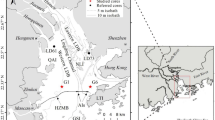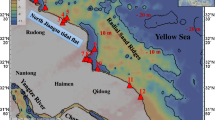Abstract
The growth of tidal flats off Zhejiang coasts in southwestern China has provided substantial areas for local agriculture and construction activities. To evaluate modern and future development of tidal flats in the region, a good understanding of sediment sources is necessary. Previous research has concluded that the Changjiang (Yangtze) River is the dominant supplier of sediments to this part of the southeast Chinese coast, despite the fact that sediment delivery from this source has been decreased markedly in the past two decades. In this study, we investigated the sources of tidal flat sediments, and the magnetic and geochemical properties of recent tidal flat sediments along the Zhejiang coast were compared with those discharged from rivers. Magnetic and geochemical properties of the tidal flat samples reveal statistically distinct sediment provenance groups. The magnetic and geochemical scatter plots show that the suspended sediment samples are naturally divided into two different groups, one including the Changjiang River and Qiantang River material, and the other including the Jiaojiang, Oujiang, and Feiyun Rivers that located in the central and southern parts of the study areas. At last, a binary source of tidal flat sediments along the Zhejiang coast was determined, with the substantial majority originating from local rivers, while a much smaller proportion emanates from the Changjiang River to the north. We conclude that the sediment contribution of the Changjiang River to tidal flat development in the region has been markedly overestimated, with important implications for management.
Similar content being viewed by others
Data Availability Statement
All data generated or analyzed during this study are included in this published article and its supplementary information files.
References
Bi L, Yang S Y, Zhao Y, Wang Z B, Dou Y G, Li C, Zheng H B. 2017. Provenance study of the Holocene sediments in the Changjiang (Yangtze River) estuary and inner shelf of the East China Sea. Quaternary International, 441: 147–161.
Blott S J, Pye K. 2001. Gradistat: a grain size distribution and statistics package for the analysis of unconsolidated sediments. Earth Surface Processes and Landforms, 26(11): 1 237–1 248.
Bouchez J, Gaillardet J, France-Lanord C, Maurice L, Maurice L, Dutra-Maia P. 2011. Grain size control of river suspended sediment geochemistry: clues from Amazon River depth profiles. Geochemistry, Geophysics, Geosystems, 12(3): Q03008, https://doi.org/10.1029/2010GC003380.
Dong Y, Zhang W G, Dong C Y, Ge C, Yu L Z. 2014. Magnetic and diffuse reflectance spectroscopic characterization of iron oxides in the tidal flat sequence from the coastal plain of Jiangsu Province, China. Geophysical Journal International, 196(1): 175–188, https://doi.org/10.1093/gji/ggt399.
France D E, Oldfield F. 2000. Identifying goethite and hematite from rock magnetic measurements of soils and sediments. Journal of Geophysical Research: Solid Earth, 105(B2): 2 781–2 795, https://doi.org/10.1029/1999JB900304.
Gao S, Collins M B. 2014. Holocene sedimentary systems on continental shelves. Marine Geology, 352: 268–294.
Ge C, Zhang W G, Dong C Y, Wang F, Feng H, Qu J G, Yu L Z. 2017. Tracing sediment erosion in the Yangtze River subaqueous delta using magnetic methods. Journal of Geophysical Research: Earth Solid, 122(11): 2 064–2 078.
Guo L C, Su N, Zhu C Y, He Q. 2018. How have the river discharges and sediment loads changed in the Changjiang River basin downstream of the Three Gorges Dam? Journal of Hydrology, 560: 259–274.
Hu P X, Jiang Z X, Liu Q S, Heslop D, Roberts A P, Torrent J, Borrón V. 2016. Estimating the concentration of aluminum-substituted hematite and goethite using diffuse reflectance spectrometry and rock magnetism: feasibility and limitations. Journal of Geophysical Research: Solid Earth, 121(6): 4 180–4 194.
Jia J, Lu H, Wang Y J, Xia D S. 2018. Variations in the iron mineralogy of a loess section in Tajikistan during the mid-pleistocene and late pleistocene: implications for the climatic evolution in Central Asia. Geochemistry, Geophysics, Geosystems, 19(4), 1 244–1 258.
Jia J, Wang Y J, Xia D S, Lu H, Gao F Y. 2019. Dust sources of last glacial Chinese loess based on the iron mineralogy of fractionated source samples. Geophysical Research Letters, 46(4): 2 103–2 110.
Li J L, Tian P, Shao S Y, Wang H F, Wang L J, Ye M Y, Zhao M Q, Zhang K Q, Cai K T, Yuan Y C, Shen X W. 2019. The change of continental coastline and its development and utilization intensity in the East China Sea. Journal of Natural Resources, 34(9): 1 886–1 901. (in Chinese with English abstract)
Li W, Hu Z X, Zhang W G, Ji R, Nguyen T T H. 2017. Influence of provenance and hydrodynamic sorting on the magnetic properties and geochemistry of sediments of the Oujiang River, China. Marine Geology, 387: 1–11.
Li X Z, Sun Y G, Mander Ü, He Y L. 2013. Effects of land use intensity on soil nutrient distribution after reclamation in an estuary landscape. Landscape Ecology, 28(4): 699–707.
Liao T, Cai T L, Liu Y F, Xia X M. 2016. Continental shoreline change in Zhejiang during the last one hundred years. Journal of Marine Sciences, 34(3): 25–33. (in Chinese with English abstract)
Liu J P, Li A C, Xu K H, Velozzi D M, Yang Z S, Milliman J D, DeMaster D J. 2006. Sedimentary features of the Yangtze River-derived along-shelf clinoform deposit in the East China Sea. Continental Shelf Research, 26(17–18): 2 141–2 156, https://doi.org/10.10167/j.csr.2006.07.013.
Liu J P, Xu K H, Li A C, Milliman J D, Velozzi D M, Xiao S B, Yang Z S. 2007a. Flux and fate of Yangtze River sediment delivered to the East China Sea. Geomorphology, 85(3–4): 208–224.
Liu Q S, Deng C L, Torrent J, Zhu R X. 2007b. Review of recent developments in mineral magnetism of the Chinese loess. Quaternary Science Reviews, 26(3–4): 368–385.
Liu X M, Hesse P, Rolph T, Begét J E. 1999. Properties of magnetic mineralogy of Alaskan loess: evidence for pedogenesis. Quaternary International, 62(1): 93–102.
Lu H Y, An Z S. 1998. Pretreated methods on loess-palaeosol samples granulometry. Chinese Science Bulletin, 43(3): 237–240.
Lu X Y, Zeng J N. 2006. Dynamic variety analysis of tidal flat resources in Zhejiang province. Journal of Marine Sciences, 24: 67–72. (in Chinese with English abstract)
Ma L F. 2002. Geological Atlas of China. Geological Press, Beijing. (in Chinese)
Maher B A, Karloukovski V V, Mutch T J. 2004. High-field remanence properties of synthetic and natural submicrometre haematites and goethites: significance for environmental contexts. Earth and Planetary Science Letters, 226(3–4): 491–505.
Maher B A, Taylor R M. 1988. Formation of ultrafine-grained magnetite in soils. Nature, 336(6197): 368–370.
Maher B A, Watkins S J, Brunskill G, Alexander J, Fielding C R. 2009. Sediment provenance in a tropical fluvial and marine context by magnetic ‘fingerprinting’ of transportable sand fractions. Sedimentology, 56(3): 841–861.
Meng X M, Derbyshire E, Kemp R A. 1997. Origin of the magnetic susceptibility signal in Chinese loess. Quaternary Science Reviews, 16(8): 833–839.
Oldfield F, Crowther J. 2007. Establishing fire incidence in temperate soils using magnetic measurements. Palaeogeography, Palaeoclimatology, Palaeoecology, 249(3–4): 362–369.
Oldfield F, Hao Q Z, Bloemendal J, Gibbs-Eggar Z, Patil S, Guo Z T. 2009. Links between bulk sediment particle size and magnetic grain-size: general observations and implications for Chinese loess studies. Sedimentology, 56(7): 2 091–2 106.
Pekel J F, Cottam A, Gorelick N, Belward A S. 2016. Highresolution mapping of global surface water and its long-term changes. Nature, 540(7633): 418–422.
Sengupta D, Chen R S, Meadows M E, Banerjee A. 2020. Gaining or losing ground? Tracking Asia’s hunger for ‘new’ coastal land in the era of sea level rise. Science of the Total Environment, 732: 139290.
Thompson R, Oldfield F. 1986. Environmental Magnetism. Allen & Unwin, London.
Torrent J, Liu Q S, Bloemendal J, Barrón V. 2007. Magnetic enhancement and iron oxides in the upper Luochuan loess-paleosol sequence, Chinese Loess Plateau. Soil Science Society of America Journal, 71(5): 1 570–1 578.
Vriend S P, van Gaans P F M, Middelburg J, de Nus A. 1988. The application of fuzzy c-means cluster analysis and non-linear mapping to geochemical datasets: examples from Portugal. Applied Geochemistry, 3(2): 213–224.
Wang W, Liu H, Li Y Q, Su J L. 2014. Development and management of land reclamation in China. Ocean & Coastal Management, 102: 415–525.
Wang X M, Xia D S, Zhang C X, Lang L L, Hua T, Zhao S. 2012. Geochemical and magnetic characteristics of finegrained surface sediments in potential dust source areas: implications for tracing the provenance of aeolian deposits and associated palaeoclimatic change in East Asia. Palaeogeography, Palaeoclimatology, Palaeoecology, 323–325: 123–132.
Wang X X, Xiao X M, Zou Z H, Chen B Q, Ma J, Dong J W, Doughty R B, Zhong Q Y, Qin Y W, Dai S Q, Li X P, Zhao B, Li B. 2020. Tracking annual changes of coastal tidal flats in China during 1986–2016 through analyses of Landsat images with Google Earth Engine. Remote Sensing of Environment, 238: 110987, https://doi.org/10.1016/j.rse.2018.11.030.
Whitmore G P, Crook K A W, Johnson D P. 2004. Grain size control of mineralogy and geochemistry in modern river sediment, New Guinea collision, Papua New Guinea. Sediment Geology, 171(1–4): 129–157.
Wu M, Shao X X, Hu F, Jiang K Y. 2008. Effects of reclamation on soil nutrients distribution of coastal wetland in South Hangzhou Bay. Soils, 40(5): 760–764. (in Chinese with English abstract)
Xu C Y, Pu L J, Zhu M. 2018. Effect of reclamation activity on coastal ecological environment: progress and perspectives. Acta Ecologica Sinica, 38(3): 1 148–1 162. (in Chinese with English abstract)
Xu F J, Li A C, Li T G, Xu K H, Chen S Y, Qiu L W, Cao Y C. 2011. Rare earth element geochemistry in the inner shelf of the East China Sea and its implication to sediment provenances. Journal of Rare Earths, 29(7): 702–709.
Zhou L P, Oldfield F, Wintle A G, Robinson S G, Wang J T. 1990. Partly pedogenic origin of magnetic variations in Chinese loess. Nature, 346(6286): 737–739.
Acknowledgment
We thank Dr. Zhiyuan WANG and Bo WANG for the fieldwork.
Author information
Authors and Affiliations
Corresponding author
Additional information
Supported by the Natural Science Foundation of Zhejiang Province, China (No. LY20D040001) and the National Undergraduate Innovation and Entrepreneurship Training Program of China
Rights and permissions
About this article
Cite this article
Jia, J., Zhang, X., Zhou, R. et al. Sources of sediment in tidal flats off Zhejiang coast, southeast China. J. Ocean. Limnol. 39, 1245–1255 (2021). https://doi.org/10.1007/s00343-020-0179-2
Received:
Accepted:
Published:
Issue Date:
DOI: https://doi.org/10.1007/s00343-020-0179-2




